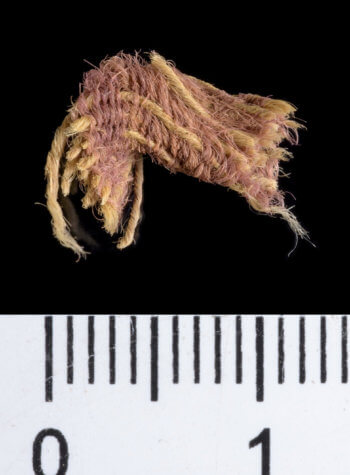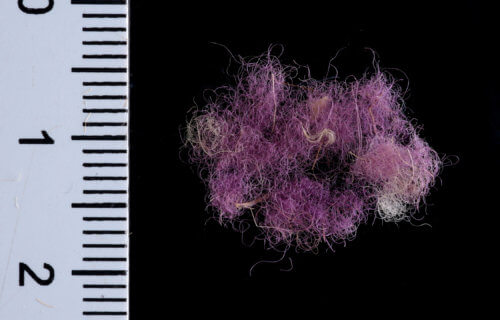TEL AVIV, Israel — A 3,000-year-old dyed thread has been discovered matching the description of royal purple from the Bible. A team in Israel says the ancient find offers a glimpse into the wardrobe of King David and King Solomon of Jerusalem from around 1,000 BC.
This marks the first time researchers have unearthed evidence of fabric dyed with royal purple dating back to this period. The remnants are of a woven fabric, a tassel and fibers of wool dyed with royal purple from the Timna Valley in southern Israel.

The site is an ancient copper production district, identified as part of the biblical Kingdom of Edom which bordered the Kingdom of Israel to the south.
“This is a very exciting and important discovery,” says Dr. Naama Sukenik, curator of organic finds at the Israel Antiquities Authority (IAA), in a media release.
“This is the first piece of textile ever found from the time of David and Solomon that is dyed with the prestigious purple dye. In antiquity, purple attire was associated with the nobility, with priests, and of course with royalty.”
Fabric dating back to biblical times
Direct radiocarbon dating confirms that the cloth dates back to around 1,000 BC, matching the biblical monarchies of David and Solomon in Jerusalem.
The Old Testament refers to the color in Song of Songs 3:9-10:
“King Solomon made for himself the carriage; he made it of wood from Lebanon. Its posts he made of silver, its base of gold. Its seat was upholstered with purple, its interior inlaid with love.”
Researchers say the dye is made from mollusks living in the Mediterranean, over 180 miles from Timna. It appears in various Jewish and Christian contexts.
This is the first time purple-dyed Iron Age textiles have been discovered in Israel or anywhere throughout the Southern Levant.
“The gorgeous shade of the purple, the fact that it does not fade, and the difficulty in producing the dye, which is found in minute quantities in the body of mollusks, all made it the most highly valued of the dyes, which often cost more than gold,” Dr. Sukenik explains.

“Until the current discovery, we had only encountered mollusk-shell waste and potsherds with patches of dye, which provided evidence of the purple industry in the Iron Age. Now, for the first time, we have direct evidence of the dyed fabrics themselves, preserved for some 3,000 years.”
Thanks to the extremely dry climate, researchers also recovered organic materials including textiles, cords, and leather from the Iron Age. They also come from the time of David and Solomon, which researchers say gives a unique glimpse into life during biblical times.
“Our archaeological expedition has been excavating continuously at Timna since 2013,” says Professor Erez Ben-Yosef from Tel Aviv University’s Archaeology Department.
“If we excavated for another hundred years in Jerusalem, we would not discover textiles from 3,000 years ago. The state of preservation at Timna is exceptional and it is paralleled only by that at much later sites such as Masada and the Judean Desert Caves.”
Digging through ‘Slaves’ Hill’
In recent years, the team has been excavating a new site inside Timna called “Slaves’ Hill.”
“The name may be misleading, since far from being slaves, the laborers were highly skilled metalworkers,” adds Prof. Ben-Yosef. “Timna was a production center for copper, the Iron Age equivalent of modern-day oil.”
“Copper smelting required advanced metallurgical understanding that was a guarded secret, and those who held this knowledge were the ‘Hi-Tech’ experts of the time,” the professor continues. “Slaves’ Hill is the largest copper-smelting site in the valley and it is filled with piles of industrial waste such as slag from the smelting furnaces. One of these heaps yielded three scraps of colored cloth. The color immediately attracted our attention, but we found it hard to believe that we had found true purple from such an ancient period.”
How ancient craftsmen made these colors
According to the team, true purple argaman comes from three species of mollusk indigenous to the Mediterranean Sea. This includes the Banded Dye-Murex, the Spiny Dye-Murex, and the Red-Mouthed Rock-Shell.
The dye is produced by a gland inside of the mollusk via a complex chemical process. Today, most scholars agree that the two precious dyes, purple argaman and light blue (azure tekhelet) come from the purple dye mollusk through different conditions and exposure to light. When exposed to light, azure appears. Without light exposure however, humans can obtain a purple hue.
These colors are often mentioned together in the ancient sources and both have symbolic and religious significance to this day. The Temple priests, David and Solomon, and Jesus of Nazareth are all described as having worn clothing colored with purple.
To reconstruct the mollusk dyeing process, Prof. Zhoar Amar traveled to Italy where he cracked thousands of mollusks and produced raw material from their dye glands. Researchers then conducted hundreds of attempts to reconstruct ancient dyeing methods.
The findings appear in the journal PLOS ONE.
SWNS writer Laura Sharman contributed to this report.
